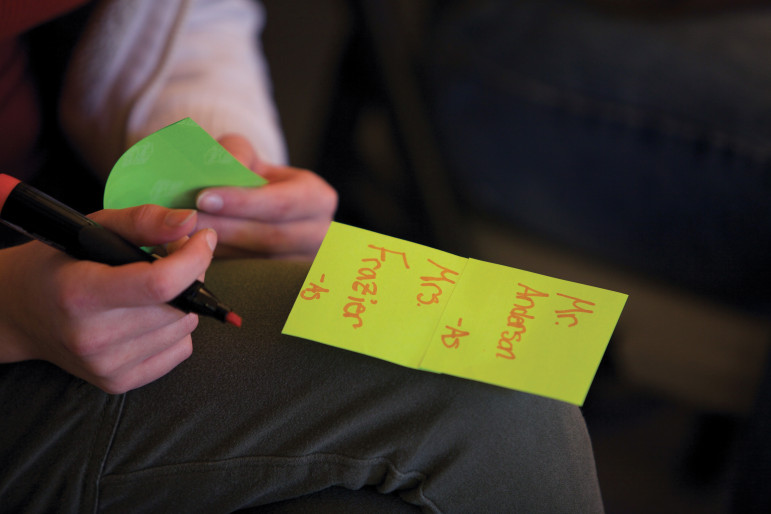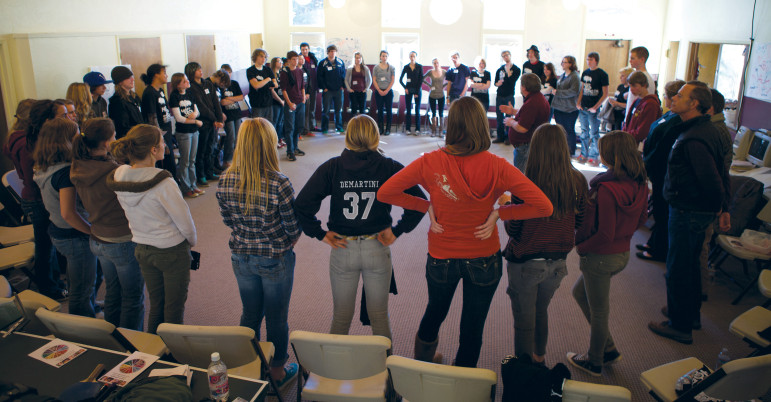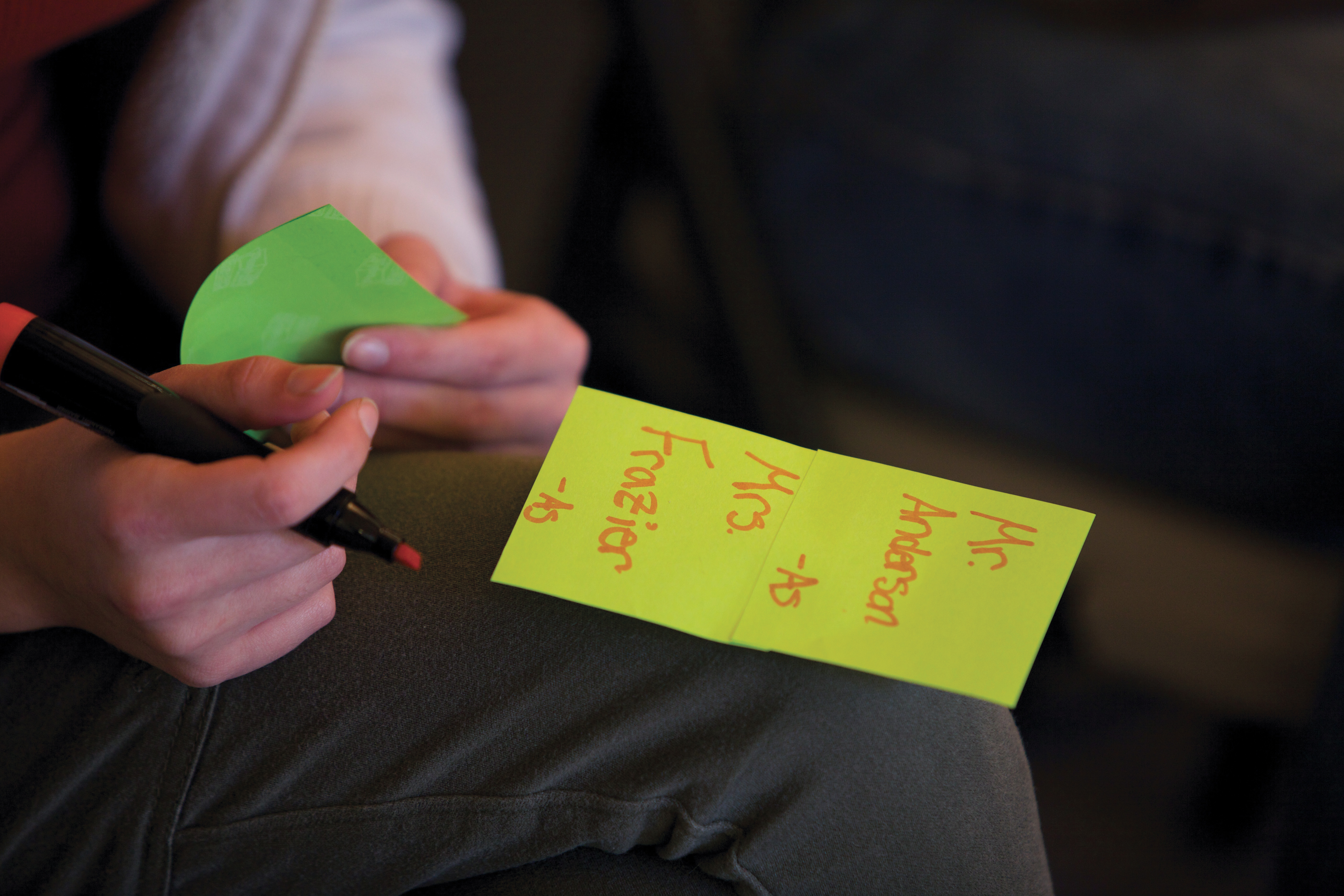
Photos courtesy of Sources of Strength
Students who take part in the suicide prevention program Sources of Strength identify trusted adults in their lives who can offer support. Here a teen writes down names of two such adults.
Rate in rural areas twice as high; innovative prevention program can work — and life can be good
When Cynthia Fontanella saw the numbers, she was surprised.
It wasn’t that almost 66,595 kids in the United States had killed themselves from 1996 to 2010, although that was bad enough.
It was that the suicide rate for rural kids was double that of urban kids — and the gap was getting wider.
The Ohio State University assistant professor and fellow researchers examined suicide data for youth ages 10 to 24 and published their results in March in the journal JAMA Pediatrics.
Males had a suicide rate of almost 20 per 100,000 in the countryside, compared with more than 10 per 100,000 in the city, according to the article “Widening Rural-Urban Disparities in Youth Suicides, United States, 1996-2010.” Among young women, the rural suicide rate was more than four per 100,000, compared with an urban rate of more than two.
Guns were the most widely used method, and more youth used guns in rural areas than in cities.
Suicide is the third-leading cause of death among young people ages 10 to 24, according to the Centers for Disease Control and Prevention (CDC). Only accidental injuries and homicides account for more deaths, according to the CDC.
Among young Native Americans, many of whom live in rural areas, suicide is the second-leading cause of death. It’s 2.5 times the national rate among ages 15 to 24, according to the Center for Native American Youth at the Aspen Institute.
Suicide is also the second-leading cause of death among lesbian, gay and transgender kids, according to the CDC.
Outside the cities
Fontanella, an assistant professor of psychiatry, is concerned with the mental health of children and how to best get services to kids who need them. She wanted a clear picture of the difference in suicide rates between rural and city kids in order to develop effective policies and programs.
So, what accounts for the higher rate of suicide among rural youth?
“The big factor is the greater access to and ownership of guns,” Fontanella said. Rural residents in many cases grow up around guns and use them for hunting. Gun ownership is more prevalent in rural areas, and, where there are more guns, there are more gun accidents and suicides, according to the Harvard Injury Control Research Center.
In addition, Fontanella said, rural areas have a chronic shortage of mental-health providers. More than half of U.S. counties — all rural — have no psychologist, psychiatrist or social worker, according to a 2012 book “Rural Mental Health.”
“Residents have to travel further for appointments and wait longer,” Fontanella said. As a result, they get treatment later and develop more severe symptoms.
They also are less likely to have health insurance.
Stigma also plays a role, too, she said. “There’s more of a culture of self-reliance” in rural communities. “People tend to believe they should solve their own problems and not turn to others for help,” Fontanella said.
Rural areas were hard hit by the recession and poverty has increased.
“Many residents out-migrate to get jobs,” she said. It changes the social structure when young people leave the area.
In rural areas gun ownership is stable or increasing, but the number of guns has dropped in urban areas, based on research in “Social Trends in American Life,” published in 2012 by Princeton University Press. Fontanella said these changes may help explain the widening gap between suicide rates among rural and urban teens.
Problems and solutions in North Dakota
For many years, North Dakota was among the states with the highest rates of youth suicide in the nation. Mark LoMurray had a front-row seat on the problem. As director of the Police Youth Bureau in Bismarck, N.D., which worked to keep kids out of trouble with the law, he often saw teens in crisis. Over a three-year period, LoMurray attended 30 teens’ funerals, many of which were suicides.
“He was filled with a sense that we could do more to get in front of this,” said his son, Scott LoMurray.
The senior LoMurray helped develop a mentoring program aimed at suicide prevention at Standing Rock and Turtle Mountain, tribal lands of the Sioux and Chippewa tribes, respectively.
His goal was to build resilience among rural and Native American teens.
“A lot of suicide-prevention programs weren’t training teens,” Scott LoMurray said. “To be effective, we have to have teens involved.”
Many programs focused on teaching the warning signs and risk factors for suicide. People could list the risk factors, but it didn’t help them get better, he said.
Today, Mark LoMurray’s program, Sources of Strength, trains teens to be peer leaders and teaches adults to work with them. Mark is executive director and Scott is deputy director.
Teen leaders learn to identify the sources of strength in their own lives. They then talk with five to 10 of their friends about the supports they have. The teen leaders create a series of messages for a wider audience. They determine the form of the message, ranging from bulletin boards to text messages to videos.
One powerful message is a list of each person’s “trusted adults” posted on a bulletin board.
Sources of Strength is based on the idea of spreading change through a social network. Just as suicide can be contagious, so can attitudes and behaviors that counter suicide, Scott said.

Sources of Strength trains a diverse group of peer leaders, encouraging them to identify where they gain strength to deal with adversity — whether from positive friendships, music, spirituality, family or other areas.
“We’re training peer leaders, not as counselors, but to be agents of change in their school and culture,” he said. “Adults can educate, but not change the underlying culture. Kids can, however.”
At first, teens may think it’s snitching to tell an adult about a friend’s suicidal thoughts. But the code of silence can shift.
The program is now in more than 300 schools in 20 states and 32 tribal communities, many of which are very remote, according to Sources of Strength.

Teens take part in a Sources of Strength training, which was developed initially in rural North Dakota. The program strengthens relationships, and evidence shows it has been successful in changing a “code of silence” around suicide.
The program, initially developed in a rural area, is adaptable to different groups of people, Scott said, and is used by youth and community organizations as well as schools.
Sources of Strength is one of the few prevention programs with evidence to show its impact, and it’s listed on the SAMHSA National Registry of Evidence-Based Programs and Practices.
Researchers, led by Peter Wyman at the University of Rochester in New York, studied the program
over three years at 18 schools in South Dakota, New York and Georgia. Six were urban schools and 12 were rural.
Researchers found the program increased students’ likelihood of referring a suicidal friend to an adult. Students were four times more likely to do so after they became peer leaders. Students who had been suicidal showed the biggest change in their willingness to seek help.
One teenager’s experience
Whitney Bischoff became a Sources of Strength peer leader her junior year at Rapid City., S.D., Central High School.
Two years before that, on the first day of ninth grade, she had faced a calamity: A childhood friend shot and killed herself.
“It was completely out of the blue,” Bischoff said. Only a few friends had had hints of trouble.
Bischoff took part in group counseling with other students who had been friends of the girl. “It never made me feel any better,” she said.
Bischoff also had problems within her family. Her father died when she was small, and her mother was an alcoholic with an abusive boyfriend.
Bischoff had never considered suicide before her friend died, but she began having suicidal thoughts. She even thought about a plan.
When the school introduced Sources of Strength, Bischoff expected “to sit around a table and be talked at,” she said. Instead, students were asked to name the things that gave them strength in their lives. The peer leaders began to feel connected to each other, she said.
[module type=”aside” align=”right”]“We’re training peer leaders, not as counselors, but to be agents of change in their school and culture. Adults can educate, but not change the underlying culture. Kids can, however.”
Scott LoMurray, deputy director, Sources of Strength
[/module]To present the program to other students they created a skit. “We wanted to come up with a new approach,” she said.
She began to realize that although she lacked family support, she had other things that gave her strength, including good friends, adult mentors, church and her own interest in theater.
“[The program] just opened my eyes to things I didn’t know how to communicate before,” she said.
Since then, life has thrown some punches. Her mother died when she was a sophomore in college. But she’s felt resilient.
Now a senior at Black Hills State University in Spearfish, S.D., Bischoff studies psychology and theater, and recently directed a production of “The Breakfast Club,” based on the movie about five struggling teenagers.
Her plan is to attend graduate school and to use Sources of Strength as a suicide-prevention program among college students.
“People need to know about it,” she said. “I know it works.”
More change needed
In addition to school and community programs that reach youth, Fontanella wants to see mental-health services made more accessible in rural areas. Mental-health care could be integrated into primary medical care in rural communities, Fontanella said. Sixty-five percent of rural residents see a primary-care doctor, she said, and integrating mental-health care would make those services more acceptable.
She would also like to see the spread of video or Internet consultations with mental-health providers, known as telemedicine. The practice has been shown effective in dealing with mental-health disorders, she said.
And not least, she said, are education campaigns on the need to store guns safely.
The Role of Guns in Rural Suicides
More than half the young people in rural areas who kill themselves do so with guns, according to research published in JAMA Pediatrics in March.
Guns, which are more prevalent in rural areas, are a particularly effective way to commit suicide, compared with ingesting substances, according to the research.
And to compound the tragedy of suicide is the fact that it’s often an impulsive act, said Frederick P. Rivara, editor of JAMA Pediatrics and professor of pediatrics at the University of Washington. He noted in an editorial that one study found 48 percent of people who attempted suicide did so only 10 minutes after thinking about the action.
People who use a gun to commit suicide will be successful more than 90 percent of the time, Rivara said.
“So restricting youth access to guns is important,” he said.
While gun-control laws are controversial, locking up guns in homes with children should not be a contentious issue, he said.
A study of gun storage practices published in 2005 in JAMA Pediatrics concluded that trigger locks and lockboxes could reduce youth gun accidents and suicides by 70 percent.
Guns should be locked away in lockboxes or safes, Rivara asserted. Trigger locks should be used to stop the trigger from being pulled by anyone without the key or combination. Communities should have education campaigns to urge safe storage, he said.
Suicide prevention programs
A sample of evidence-based programs on the SAMHSA National Registry of Evidence-Based Programs and Practices
- American Indian Life Skills Development / Zuni Life Skills Development — Teachers and community resource leaders deliver lessons that include activity and role-playing to teach life skills and lessen the risk of suicide.
- CAST (Coping and Life Support Training) — Youth ages 14-19 who have been identified as at risk for suicide get social support and life-skills training in small groups. Held in high school setting and led by counselors, nurses and teachers. reconnectingyouth.com/programs/cast/
- LEADS: For Youth (Linking Education and Awareness of Depression and Suicide) — A curriculum for high school students to increase understanding of depression and suicide and help develop help-seeking behavior.
- Lifelines Curriculum — A school-wide, comprehensive suicide prevention program for middle- and high-school students. It encourages help-seeking and promotes a caring, competent school community.
- Model Adolescent Suicide Prevention Program — Originally developed for a small American Indian tribe, the program involves the community and takes a public health approach.
- Reconnecting Youth: A Peer Group Approach to Building Life Skills — This program targets youth ages 14-19 who have poor school achievement and are at risk for dropping out. It teaches skills to build resiliency and strengthen characteristics that protect against suicide.
- Sources of Strength — A universal program that users peer leaders to build protective influences among youth. Adaptable for various settings and groups.


























